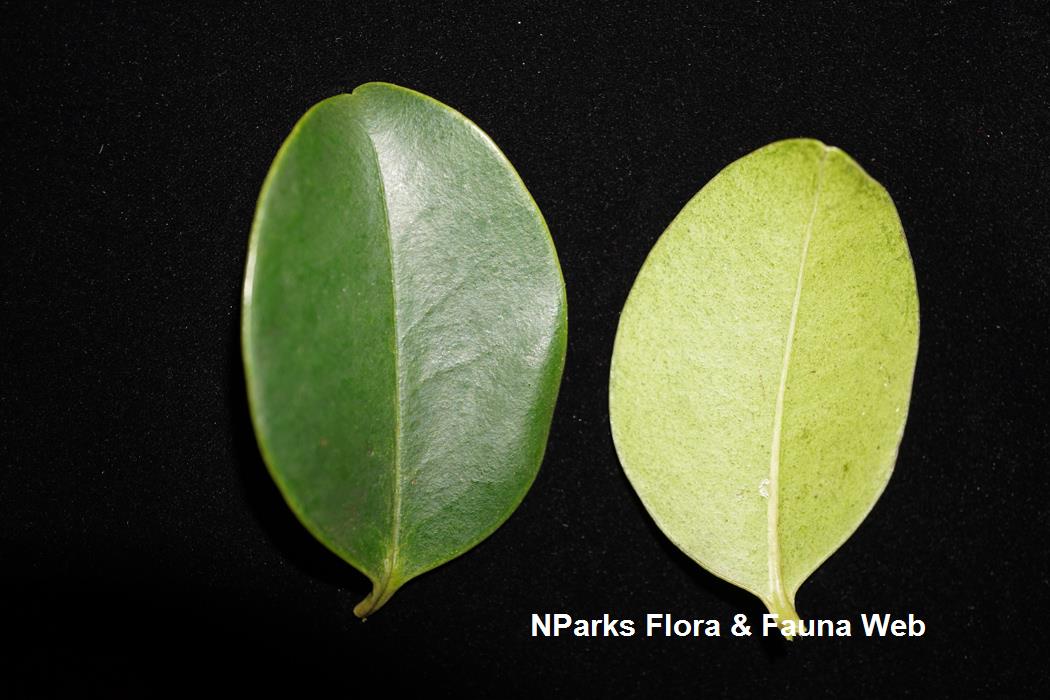
Back
Memecylon cantleyi Ridl.
| Family Name: | Melastomataceae |
| Synonyms: | Memecylon steenisii, Memecylon dissitum |
| Common Name: | Cantley's Memecylon |
Name
Classifications and Characteristics
| Plant Division | Angiosperms (Flowering Seed Plants) (Dicotyledon) |
|---|---|
| Plant Growth Form | Tree (Small (6m-15m), Shrubby (1m-5m)), Shrub |
| Lifespan (in Singapore) | Perennial |
| Mode of Nutrition | Autotrophic |
| Plant Shape | Irregular |
| Maximum Height | 3 m to 15 m |
Biogeography
| Native Distribution | Thailand, Peninsular Malaysia, Singapore, Indonesia |
|---|---|
| Native Habitat | Terrestrial (Primary Rainforest) |
| Preferred Climate Zone | Tropical |
| Local Conservation Status | Native to Singapore (Critically Endangered (CR)) |
Description and Ethnobotany
| Growth Form | It is a shrub up to 3 m tall, or small tree up to 15 m tall. |
|---|---|
| Trunk | Bark thin, smooth, pale grey-tan. |
| Foliage | Its opposite, stalked leaves have leathery leaf blades that are lance- to egg-shaped, and 8–20 by 3–7.5 cm, with scarcely visible venation, and prolonged tips. |
| Flowers | Its flowering clusters are 1.5–2.5 cm long, and found at the twigs. Each shoot bears up to 10 flowers that are 3–4 mm wide, with four purplish-pink petals. |
| Fruit | Its roundish fruits are 10 mm-wide berries that ripen dark purple. |
| Others - Plant Morphology | Probably the native Memecylon species most threatened with extinction, currently known in Singapore from just 2 wild specimens growing within the Singapore Botanic Gardens' Rainforest. These specimens may have descended from the holotype specimen collected from the same area in 1907 by British botanist and former director of the Gardens, Henry Nicholas Ridley (1855-1956), based on which the species was first described to science. |
| Habitat | It grows in the understory of lowland rainforests. It occurs locally in Singapore Botanic Gardens (Rainforest). |
| Associated Fauna | Its flowers are insect-pollinated. Its fruits are eaten by birds. |
| Cultivation | Tolerant of partial shade and semi-montane temperatures. Propagate by seeds and tissue culture. |
| Etymology | Genus epithet 'Memecylon' derived from 'memaecylon' -- as used by ancient Greek philosophers Dioscorides and Pliny to describe the red fruits of Arbutus unedo (Oriental Strawberry Tree) -- alluding to the pink to reddish berries often produced by members of the 'Memecylon' genus. Species epithet 'cantleyi' named after Scotsman Nathaniel Cantley (d. 1888), the Kew-trained superintendent of the Singapore Botanic Gardens from 1880-1888. |
Landscaping Features
| Landscaping | It is suitable for planting in parks for its ornamental flowers and fruits. |
|---|---|
| Desirable Plant Features | Ornamental Flowers, Ornamental Fruits |
| Landscape Uses | General, Parks & Gardens |
| Thematic Landscaping | Naturalistic Garden |
Fauna, Pollination and Dispersal
| Fauna Pollination Dispersal Associated Fauna | Bird-Attracting (Fruits) |
|---|---|
| Pollination Method(s) | Biotic (Fauna) |
| Seed or Spore Dispersal | Biotic (Fauna) |
Plant Care and Propagation
| Light Preference | Semi-Shade |
|---|---|
| Water Preference | Moderate Water |
| Plant Growth Rate | Moderate |
| Rootzone Tolerance | Fertile Loamy Soils, Well-Drained Soils, Moist Soils |
| Maintenance Requirements | Moderate |
| Propagation Method | Seed, Tissue Culture |
Foliar
| Foliage Retention | Evergreen |
|---|---|
| Mature Foliage Colour(s) | Green |
| Mature Foliage Texture(s) | Leathery |
| Foliar Type | Simple / Unifoliate |
| Foliar Arrangement Along Stem | Opposite |
| Foliar Attachment to Stem | Petiolate |
| Foliar Shape(s) | Non-Palm Foliage (Elliptical, Lanceolate) |
| Foliar Venation | Pinnate / Net |
| Foliar Margin | Entire |
| Foliar Apex - Tip | Acuminate |
| Foliar Base | Acute |
| Typical Foliar Area | Mesophyll ( 45cm2 - 182.25 cm2 ) |
Non - Foliar and Storage
| Trunk Type (Non Palm) | Woody |
|---|---|
| Bark Colour(s) | Grey-tan |
| Stem Type & Modification | Woody |
| Root Type | Underground (Tap Root, Fibrous Root) |
Floral (Angiosperm)
| Flower & Plant Sexuality | Bisexual Flowers |
| Flower Colour(s) | Blue, Pink, Purple, White |
|---|---|
| Flower Grouping | Cluster / Inflorescence |
| Flower Location | Axillary |
| Flower Symmetry | Radial |
| Inflorescence Type | Umbel |
| Flowering Habit | Polycarpic |
Fruit, Seed and Spore
| Mature Fruit Colour(s) | Purple |
|---|---|
| Fruit Classification | Simple Fruit |
| Fruit Type | Fleshy Fruit , Berry |
Image Repository
Others
| Master ID | 29686 |
|---|---|
| Species ID | 3995 |
| Flora Disclaimer | The information in this website has been compiled from reliable sources, such as reference works on medicinal plants. It is not a substitute for medical advice or treatment and NParks does not purport to provide any medical advice. Readers should always consult his/her physician before using or consuming a plant for medicinal purposes. |














